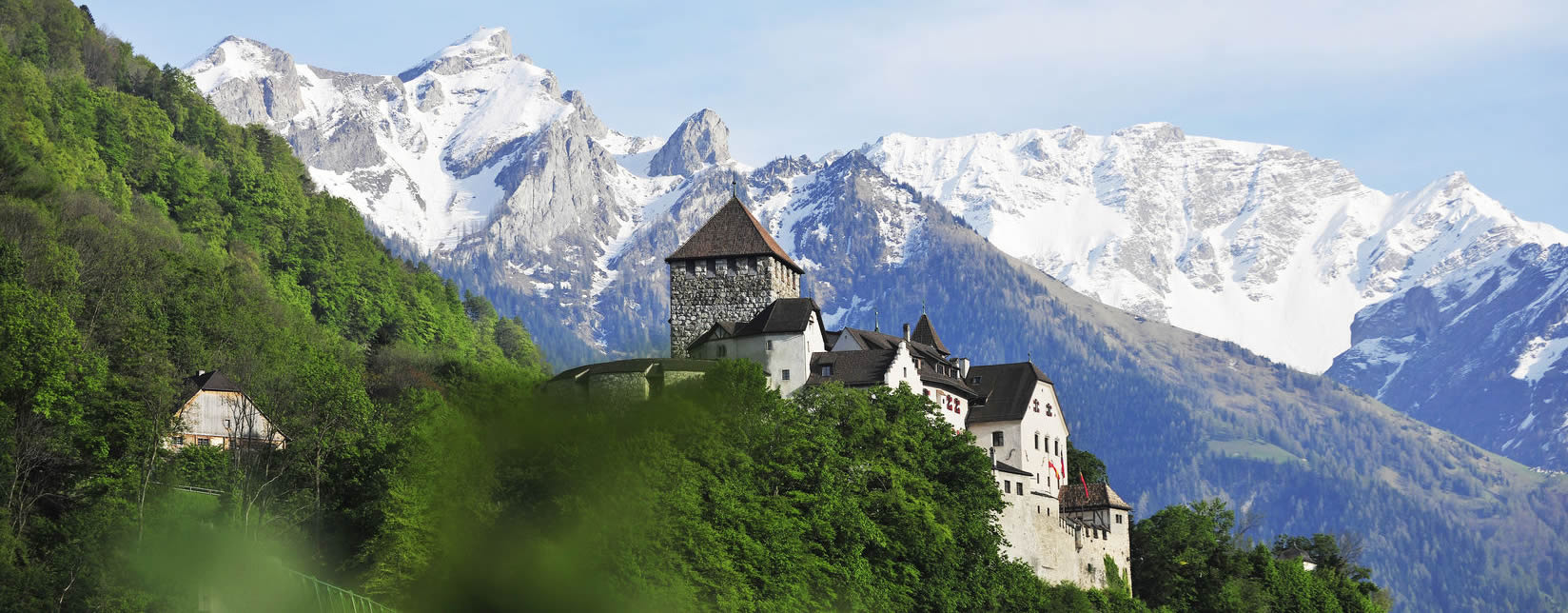Language/Swiss-german/Culture/Liechtenstein-Timeline
< Language | Swiss-german | Culture
Jump to navigation
Jump to search
Rate this lesson:
Historical Timeline for Liechtenstein - A chronology of key events
Liechtenstein Timeline[edit | edit source]
Prehistory[edit | edit source]
- Archaeological excavations trace the settlement of Liechtenstein back to at least the 5th millennium BC. The country is located at the crossroads between the north-south alpine route and the east-west migration route. The hills of the Rhine Valley, the hill on which Balzers Castle sits in the south and Eschnerberg in the north seem to have been populated since the Upper Paleolithic. Only the upper regions were occupied, the Rhine representing a permanent threat by its frequent floods in the plains. Certain place names allow us to think that the Rhaetians colonized the current territory of Liechtenstein, a territory which also probably undergoes a Celtic influence from the west.
Roman period[edit | edit source]
- Rhaetia was conquered by the Romans and declared a Roman province in 15 BC. A Roman road crossed the region from north to south, crossing the Alps via the Splügen pass and following the edge of the flood plains along the right bank of the Rhine - plains that had long remained uninhabited due to frequent flooding . Roman villas unearthed at Schaanwald and Nendeln and a fort erected by the Romans in the 4th century to protect themselves against attacks from the Alamans bear witness to the density of colonization.
Middle Ages[edit | edit source]
- With the fall of the Roman Empire and the arrival of the Alamans, Latin and Germanic cultures coexisted for centuries.
- The region was incorporated into the Carolingian Empire and became a Frankish county in 806. In the tenth century, Rhaetia was ruled by the counts of Brégence, whose lineage died out in 1152. The old Rhaetia was then divided into different counties over the generations.
- When the Duchy of Swabia lost its Duke in 1268, all the vassals of that Duchy became direct vassals of the Imperial throne.
- Vaduz County was formed in 1342 as a small subdivision of Werdenberg County of the Montfort dynasty of Vorarlberg. From 1416, the territory was ruled by the barons of Brandis. These definitively fixed the borders of Liechtenstein by acquiring the northern part of the seigniory of Schellenberg: thus the borders of Liechtenstein have remained identical since 1434.
- In 1510, the last Baron de Brandis sold the estates of Vaduz and Schellenberg to the Counts of Sulz. Established in Klettgau, they ruled these estates from outside. Roman Catholics, they made a point of preserving loyalty to Rome in the county during the Reformation.
- The fifteenth century witnessed three wars, but the black period intervened in the seventeenth century, with epidemics, fallout from the Thirty Years' War - even if Liechtenstein was not directly involved - and, moreover, because of 'a witch hunt during which more than a hundred people were persecuted and executed.
- In 1613, the counts of Sulz sold the counties of Vaduz and Schellenberg to the counts of Hohenems who wanted to create a buffer state between Switzerland and Austria. Since 1608, the rulers of Liechtenstein had been elevated to the rank of princes, but this title was not sufficient to allow their entry into the Council of Princes.
Liechtenstein Dynasty[edit | edit source]
- The Liechtenstein dynasty had large tracts of land, mainly in Moravia, Lower Austria and Styria. However, these large and rich territories were fiefdoms dependent on the authority of other lords, in particular various branches of the Habsburgs, of which the Liechtenstein were close advisers, and none benefited from imperial immediacy (i.e. say without any other lord than the Emperor). This is why the Liechtenstein dynasty could not obtain a seat on the Diet of the Empire, the Reichstag, nor enjoy the prestige and influence that this engendered. In order to have a chance to accede to the Council of Princes, their attention turned to the domains of Vaduz and Schellenberg. Prince Johann Adam I of Liechtenstein bought the domain of Schellenberg in 1699 and the county of Vaduz in 1712. By acquiring this small territory made up of mountain villages, which was directly subordinated to the Holy Empire since there was no longer any Duke of Swabia, the Prince of Liechtenstein achieved his goals.
- The territory then took the name of the family ruling the country. It is therefore the Liechtenstein dynasty which gave its name to the principality, and not the other way around. This name comes from the Liechtenstein castle in Lower Austria, which it owned from around 1140 until the 13th century and from 1807 to the present day. On January 23, 1719, Emperor Charles VI of the Holy Roman Empire decreed that the counties of Vaduz and Schellenberg would be promoted to the rank of imperial principality of Liechtenstein.
- Liechtenstein became a sovereign state in 1806, when it joined the Confederation of the Rhine created by Napoleon following the dissolution of the Holy Roman Empire. While almost all the small German states disappeared, Liechtenstein succeeded in integrating this Confederation of the Rhine while remaining independent. During this period, the French occupied the country for a few years, then Liechtenstein regained its independence in 1815, within the Germanic Confederation.
- In the nineteenth century, Liechtenstein experienced a difficult situation. Economically isolated (its trade was stagnating), the principality increasingly became an underdeveloped rural state, under the weight of heavy feudal taxes. The ideas of the revolution of 1848 found a favorable echo there. The population, by petitions, called on the prince to grant it a new constitution, free elections, and the abolition of feudal taxes.
- A customs agreement with Austria was concluded in 1852. This union attached Liechtenstein to the Austrian monetary system and also laid the foundations for economic development in the second half of the 19th century. Manufactures grew, the first factories were established and the first bank, Spar und Leihkasse, was founded in 1861. Liechtenstein was connected to the international rail network in 1872, when the Austrian railways inaugurated the Feldkirch – Buchs line.
- In 1862, a new constitution established a diet representing the people. In 1868, after the dissolution of the German Confederation, Liechtenstein dissolved its army of 80 men, and declared its permanent neutrality, a neutrality respected during the two world wars.
- Until the end of World War I, Liechtenstein was closely linked with Austria, but the economic disaster created by the conflict forced the country to enter into a monetary and customs union with Switzerland. In 1919, the Liechtentein and Switzerland signed a treaty by which Switzerland ensures the representation of the interests of Liechtenstein at a diplomatic and consular level in the countries where Switzerland is represented and not the principality. This agreement was followed in 1920 by a postal services convention.
- This period is also that of a new constitution (1921) granting the people mechanisms of direct democracy and avoiding any risk of foreign predominance: thus, the Prime Minister of Liechtenstein must henceforth be a native of the principality.
- In 1927, Liechtenstein was hit by catastrophic floods, following the rupture of a Rhine dike on September 25, 19273. The Rhine withdrew only on December 304, and the following year more than 800 volunteers from 20 countries5 came to help rebuild and rehabilitate the land6.
- In 1938, Prince Franz Joseph II of Liechtenstein became the first Prince of Liechtenstein to reside permanently in the principality. He ruled the country from Vaduz Castle until his death in 1989.
Contemporary period[edit | edit source]
- After World War II (in which Liechtenstein remained neutral), the country's low taxes encouraged economic growth, and the country became an increasingly important financial center. Among the reasons for this success, we can cite the customs union with Switzerland and the adoption of the Swiss franc as the national currency, a stable policy and social conditions.
- In 1989, Prince Hans-Adam II succeeded his father. In 1996, Russia put an end to a point of contention between the two countries by returning the archives of the Liechtenstein family.
- In order to make its voice heard at an international level, despite its small size, Liechtenstein has joined several international organizations since the 1950s. In 1978, the country became a member of the Council of Europe, before joining the Organization of United Nations in 1990, the European Free Trade Association in 1991, the European Economic Area (EEA) and the World Trade Organization (WTO) in 1995.
- In 2007, a troop of 170 Swiss soldiers accidentally entered the Liechtenstein territory by mistake during a night march and in bad weather conditions. The soldiers realized their mistake and turned back, but the event sparked a diplomatic incident between the two countries.
Source[edit | edit source]
World Timelines[edit source]


